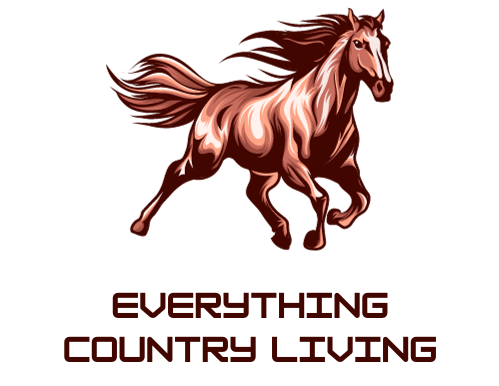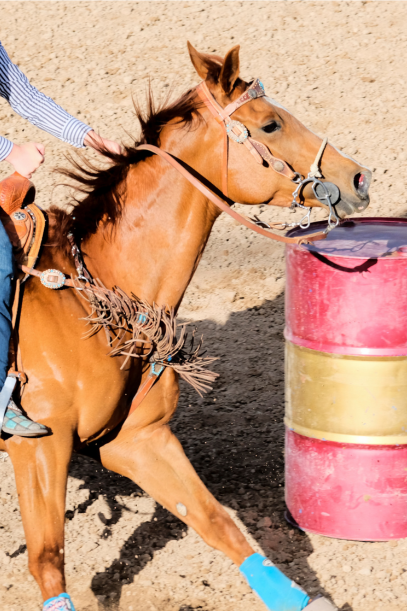
Are you ready to take your barrel racing to the next level? If you’re searching for that competitive edge that will turn you from an ordinary rider into an extraordinary one, it’s time to explore the world of barrel racing bits.
These powerful tools can make all the difference in your performance, helping you navigate those tight turns and shave off those precious milliseconds.
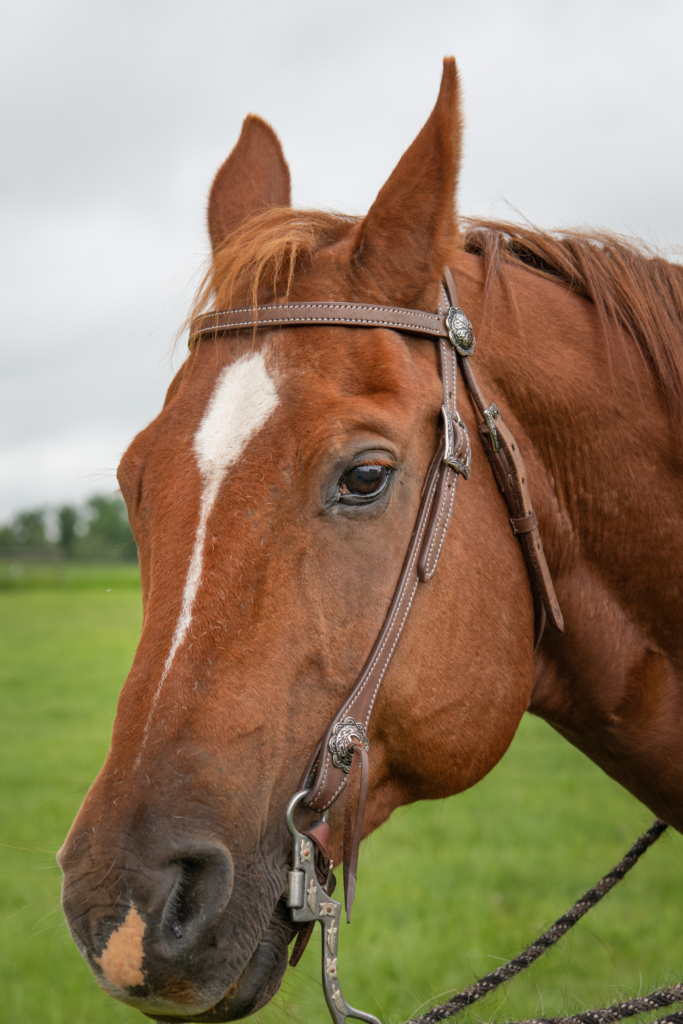
In this article, we’ll dive deep into the world of barrel racing bits, exploring the different types and their unique benefits. From snaffles to gag bits, we’ll explore the mechanics behind each design and how they can enhance your communication with your horse.
Whether you’re a novice rider looking to upgrade your gear or a seasoned pro searching for a bit that complements your style, this article has got you covered. Get ready to unleash the power of the right barrel racing bit and watch your performance soar to new heights.
The importance of choosing the right barrel racing bit
Choosing the right barrel racing bit is crucial to your success in the sport. It’s not just about finding a bit that fits your horse’s mouth; it’s about finding a bit that allows you to communicate effectively and efficiently with your horse during high-speed turns. The right bit can provide the necessary control and responsiveness, giving you the ability to guide your horse through the barrels with precision.
One of the key factors to consider when choosing a barrel racing bit is the horse’s level of training and experience. Novice horses may require a simpler bit, such as a snaffle, to help them understand the cues and develop the necessary skills for barrel racing. On the other hand, more advanced horses may benefit from a bit with more leverage like a gag bit or a curb bit that will give you more whoa if your horse is over powering you.
Types of barrel racing bits
There is a wide variety of barrel racing bits available in the market, each with its own unique design and purpose. Let’s explore some of the most common types and their benefits:
- Snaffle Bits: Snaffle bits are a popular choice for barrel racing due to their simplicity and gentle action. These bits work by applying direct pressure to the horse’s tongue, bars, and corners of the mouth. They are ideal for novice horses or those with a sensitive mouth. Snaffle bits promote lateral flexion and help develop a soft and responsive mouth.
- Gag Bits: Gag bits provide additional leverage and control to the rider. They work by placing pressure on the poll and mouth simultaneously, encouraging the horse to flex at the poll and lift their shoulders. Gag bits can be a valuable tool for horses that need more help in maintaining balance and collection during turns.
- Combination Bits: Combination bits combine the action of a snaffle and a gag bit. They offer both direct pressure with the nose band and give leverage with the shanks, making them versatile for different training stages or individual horse needs. They provide a balanced combination of control and communication.

Factors to Consider When Selecting a Barrel Racing Bit
When selecting barrel racing bits, there are several factors to consider to ensure the best fit for both you and your horse. These include:
- Rider’s Hands: Consider your own riding style and the level of control you have with your hands. A bit that requires subtle cues and light pressure may be better suited for experienced riders, while novice riders may benefit from a snaffle bit that provides more forgiveness and a clearer signal to the horse.
- Horse’s Mouth Conformation: The shape and sensitivity of your horse’s mouth should be taken into account. Some horses may have low palates, thick tongues, or sensitive bars. Adjust the bit you use accordingly.
- Training Level: Consider your horse’s training level and experience in barrel racing. Novice horses may require a simpler bit to help them understand the cues and develop the necessary skills, while more advanced horses may benefit from a bit with more precision and control.
- Bit Material: The material of the bit can also affect your horse’s comfort and response. Stainless steel, copper or sweet iron bits are commonly used due to their durability and acceptance by most horses.
Proper Bit Fitting and Adjustment
When it comes to barrel racing, proper bit fitting and adjustment are essential for optimal performance. A well-fitted bit ensures clear and effective communication between rider and horse, resulting in better control and responsiveness. The first step in finding the right bit is to consider the size and shape of your horse’s mouth. It’s crucial to choose a bit that fits comfortably without causing any pain or discomfort.
In addition to finding the right bit, proper adjustment is key. The bit should be positioned correctly in the horse’s mouth, with the mouthpiece resting on the bars and the rings or shanks positioned at the appropriate level. Adjusting the bit too high or too low can cause discomfort and hinder communication. Take the time to experiment with different adjustments and observe your horse’s response to find the perfect fit.
Finding the right bit and adjusting it properly may take some trial and error, but the effort is well worth it. A well-fitted and properly adjusted bit can make all the difference in your barrel racing performance, giving you the control and communication you need to excel on the course.
Different Types of Bits
One popular option for barrel racing is the snaffle bit. Snaffles have a simple design, consisting of a jointed mouthpiece and a set of rings on either side. This bit is a great choice for beginners or horses that are sensitive to pressure. The jointed mouthpiece allows for direct communication with the horse mouth. When fitting a snaffle bit, ensure that there is a small amount of wrinkle in the corners of the horse’s mouth, indicating a good fit. They can be smooth or have a twisted wire design.
Twisted wire snaffle bits are suitable for horses that require more control and responsiveness. However, it’s important to use this type of bit with caution, as it can be harsh if not used correctly. Always start with lighter pressure and gradually increase as needed, ensuring that your horse is comfortable and responsive.
For horses that are more advanced, a gag bit may be a suitable choice. Gag bits have a sliding mouthpiece and a set of rings that allow for leverage and increased control. When using a gag bit, it’s important to have a solid foundation of training and communication with your horse. Gag bits can be quite severe, so it’s crucial to use them responsibly and with proper technique.
Training and transitioning to a new bit
Transitioning to a new bit can be a significant step in your barrel racing journey. Whether you’re upgrading to a more advanced bit or trying a different style, proper training and transitioning are essential for a smooth and successful transition.
When transitioning to new barrel racing bits, it’s best to introduce it gradually. Start by incorporating the new bit into your training sessions, using it for short periods of time and focusing on basic exercises. This allows your horse to become familiar with the new bit and adjust to its feel and pressure. Gradually increase the amount of time you spend using the new bit, always monitoring your horse’s response and comfort level.
During the transition period, it’s important to pay close attention to your horse’s cues and reactions. Watch for any signs of discomfort or resistance, such as head tossing, teeth grinding, or excessive salivation. These signs may indicate that the new bit is causing discomfort or confusion. If this occurs, go back to your previous bit and reassess your training approach before attempting the transition again.
Remember, transitioning to a new bit is a process that requires time, and patience. It’s important to prioritize your horse’s comfort and well-being throughout the transition. With the right approach and training, you can successfully transition to a new bit and unlock a whole new level of performance in your barrel racing journey.
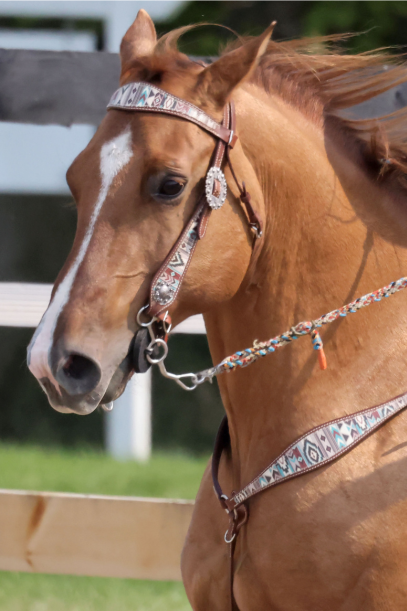
Training
Don’t underestimate the power of practice and repetition. Consistent training and repetition with your chosen bit will help you and your horse develop a strong connection. Focus on refining your cues, timing, and body position, and aim for smooth and seamless transitions between turns. The more you practice, the more confident and in sync you will become with your horse, resulting in improved performance on the barrel racing course.
Many top riders and trainers will practice in one bit but then have another one that they use only for competitions. For example, they might use an O-ring snaffle as their everyday bit. They will then find a bit, such as a gag bit, that their horse likes to run in and keep that one strictly for competition use.
Beginner Barrel Racing Bits
Most trainers will start a young horse in a snaffle to gain the framework it needs to transition to a curb bit. Such a foundation includes lateral flexion, collection, responsiveness to leg cues and more. Again, this depends on the method of training the trainer uses.
O-ring and offset D-ring snaffles are great bits for starting young colts, training exercises, introducing a new riding discipline or softening an older, more seasoned horse’s mouth.
Weaver Leather Professional Ring Snaffle Bit
- Stainless Steel
- 5″ Copper Mouth
- 3 inch Rings
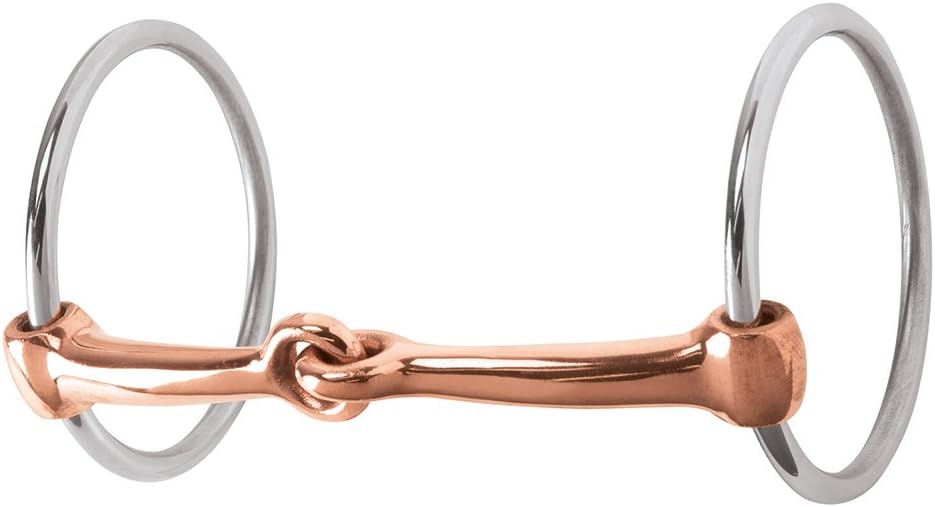
Western SS Sweet Iron Snaffle D-Ring Barrel racing bit
The Sweet Iron Snaffle D-Ring Bit features a 5″ mouth piece with 3″ Offset D-rings. This D-ring snaffle has a copper inlay creating a sweet tasting bit for your horses. The sweet iron mouth piece with added copper inlay helps your horses salivate which helps prevent them from getting a dry mouth.

Gag bits
Gag bits offer more control then a snaffle. A gag bit is designed to slide up and down on the bit rings. They help to create flex and lift the shoulder. They combine shanks with a snaffle and come in different variations. Some have longer shanks.
The Brittany Pozzi Collection by Professionals Choice Equine Three Piece Twisted Wire Bit
“This mouthpiece offers similar benefits of the twisted wire snaffle with added flex and bend.” – Brittany Pozzi
- Twisted Wire Snaffle
- 6 1/2in Cheeks
- 5 1/2 in. Mouth
- Medium Shank
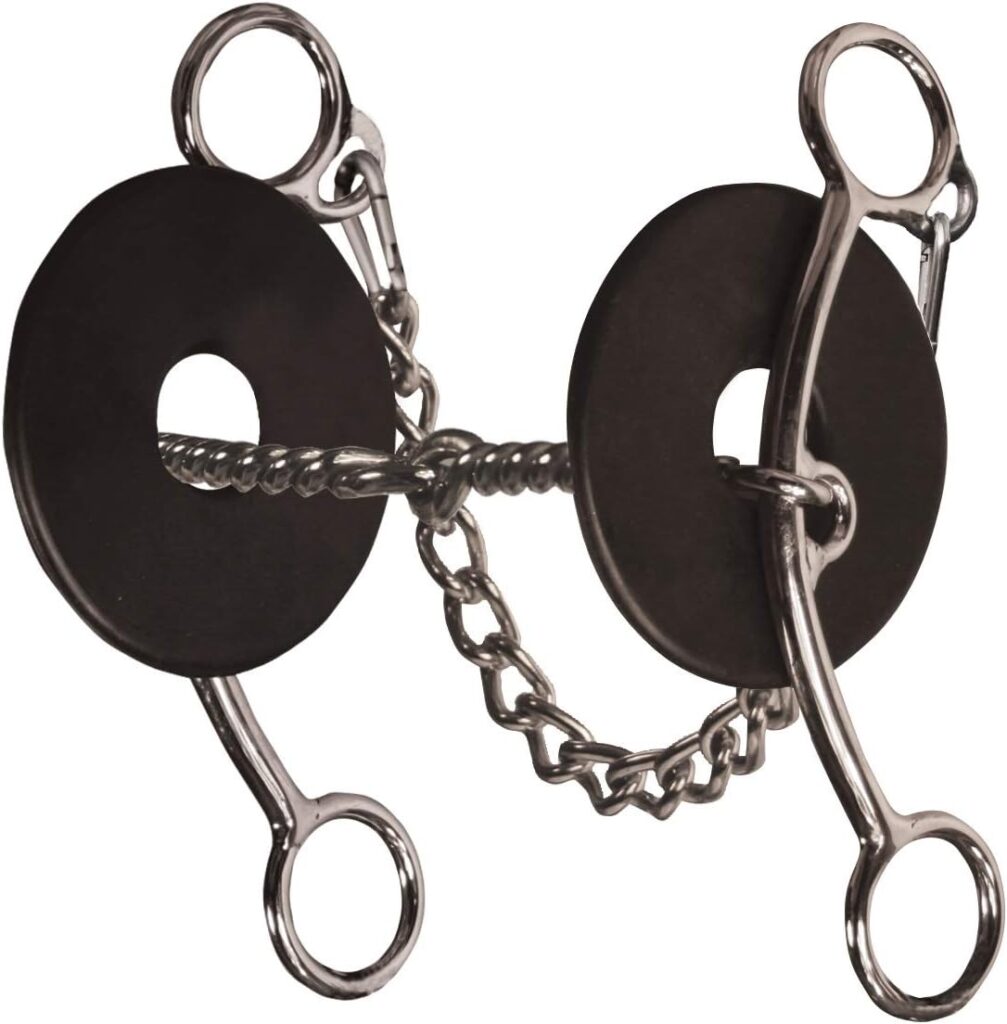
Josey Million Dollar barrel racing bits
This gag bit is designed to work with horses in all stages of barrel racing training and competition endorsed by Martha Josey. The Million Dollar barrel racing bit has won a lot of money for many riders.
This bit features a stainless steel 3-piece twisted wire dog bone snaffle mouthpiece and a rope noseband. Equipped with a 5″ shank, the Million Dollar bit is ideal because pressure is evenly distributed on the nose, bars, corners of the mouth, curb, and poll.
I have had horses that worked well in this bit and I have had horses that absolutely hated it. Make sure the nose band is not tight or putting any pressure on the horse unintentionally. I wrap the nose band with vet leg wrap to make it softer.
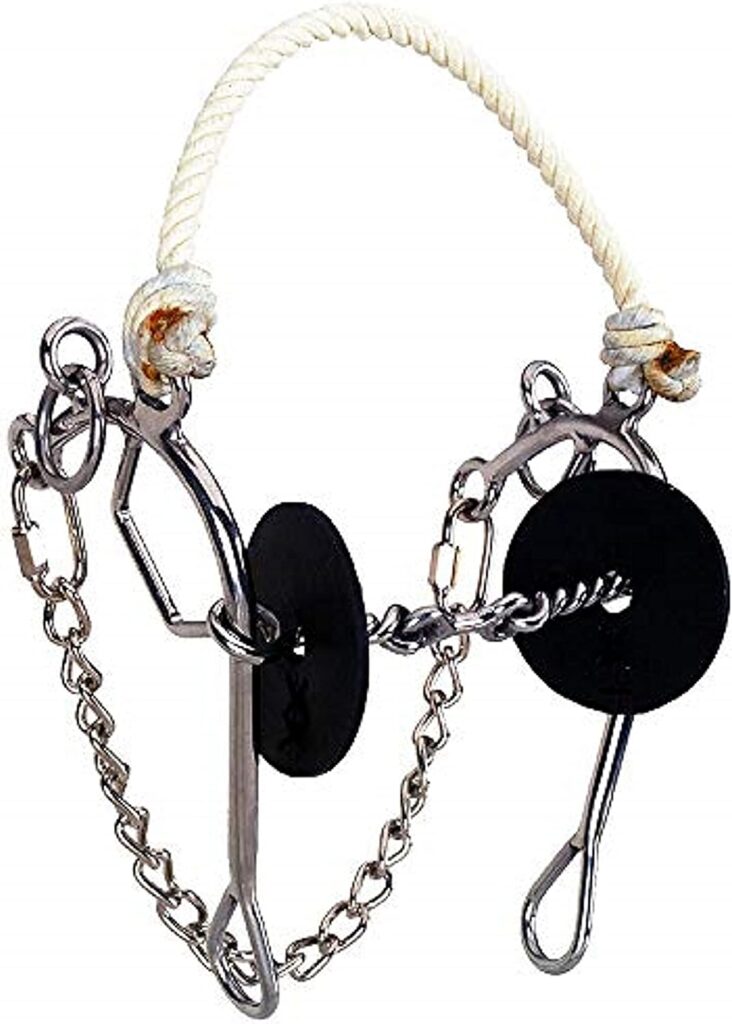
Curb Bits
Any bit with a shank is considered a curb. Because a curb gives a rider extra leverage in comparison to a snaffle, it is one of the better barrel racing bits for strong horses that are a bit out of control and pushy.
Professional’s Choice Futurity Bit
This is a good bit for a horse who is ready to be transitioned from a snaffle to a shank bit. The short gag has a quicker response time and can be more harsh if you are not careful and are rough with your hands. It allows the rider to pick up a horse when needed, allowing for greater control.
- Medium Port Futurity Bit
- 5-3/4in Mouthpiece
- 5-1/2in Cheek
- 1-1/2in Port
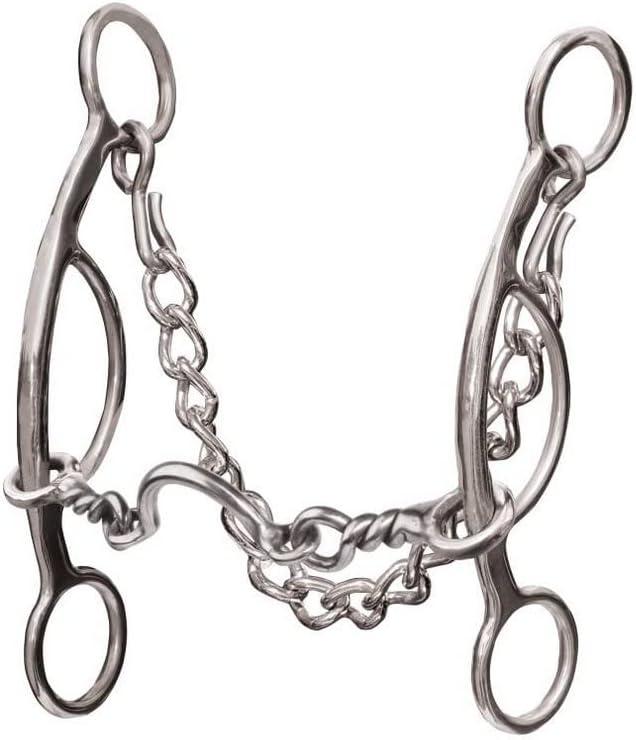
Is a Snaffle Bit Always Best?
A snaffle is considered to be the mildest bit but in the wrong hands it can cause your horse to become hard mouthed if you have to constantly pull on his face. If your horse is not responding anymore to a snaffle it might be better to switch to a gag bit with long shanks. This will give your horse time to react and make the right move before you use leverage on him. This can help him become more responsive to your cues again.
Conclusion to Barrel Racing Bits
In conclusion, barrel racing bits are powerful tools that can determine whether you win or lose a barrel race. By understanding the different types of bits available and their unique benefits, you can find the perfect bit that complements your riding style and enhances your communication with your horse. Proper bit fitting and adjustment are crucial for optimal performance, ensuring comfort and effective communication. Training and transitioning to a new bit require patience, proper training, and a solid foundation of communication with your horse.
Remember, finding the right barrel racing bit is a personal journey that requires experimentation and observation. Take the time to understand your horse’s needs.
I hope you found this post on barrel racing bits helpful. What is your go to bit for barrel racing?
Check out this post on choosing the best saddle pads here. A good quality saddle pad that fits your horse well makes a huge difference in your horses performance.
Have a great day and I happy riding!
